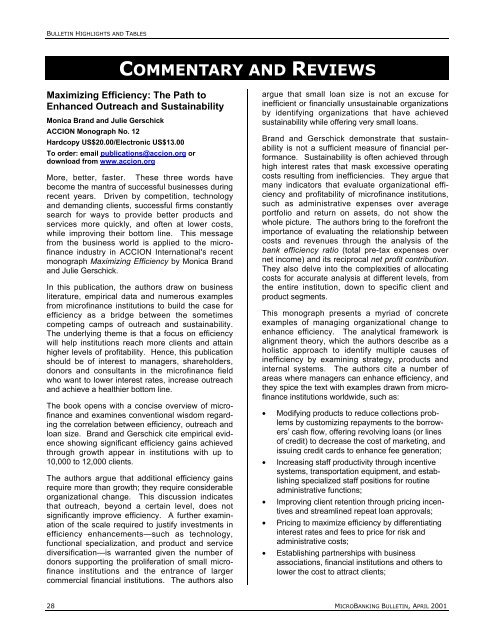the microbanking bulletin - Microfinance Information Exchange
the microbanking bulletin - Microfinance Information Exchange
the microbanking bulletin - Microfinance Information Exchange
You also want an ePaper? Increase the reach of your titles
YUMPU automatically turns print PDFs into web optimized ePapers that Google loves.
BULLETIN HIGHLIGHTS AND TABLESCOMMENTARY AND REVIEWSMaximizing Efficiency: The Path toEnhanced Outreach and SustainabilityMonica Brand and Julie GerschickACCION Monograph No. 12Hardcopy US$20.00/Electronic US$13.00To order: email publications@accion.org ordownload from www.accion.orgMore, better, faster. These three words havebecome <strong>the</strong> mantra of successful businesses duringrecent years. Driven by competition, technologyand demanding clients, successful firms constantlysearch for ways to provide better products andservices more quickly, and often at lower costs,while improving <strong>the</strong>ir bottom line. This messagefrom <strong>the</strong> business world is applied to <strong>the</strong> microfinanceindustry in ACCION International's recentmonograph Maximizing Efficiency by Monica Brandand Julie Gerschick.In this publication, <strong>the</strong> authors draw on businessliterature, empirical data and numerous examplesfrom microfinance institutions to build <strong>the</strong> case forefficiency as a bridge between <strong>the</strong> sometimescompeting camps of outreach and sustainability.The underlying <strong>the</strong>me is that a focus on efficiencywill help institutions reach more clients and attainhigher levels of profitability. Hence, this publicationshould be of interest to managers, shareholders,donors and consultants in <strong>the</strong> microfinance fieldwho want to lower interest rates, increase outreachand achieve a healthier bottom line.The book opens with a concise overview of microfinanceand examines conventional wisdom regarding<strong>the</strong> correlation between efficiency, outreach andloan size. Brand and Gerschick cite empirical evidenceshowing significant efficiency gains achievedthrough growth appear in institutions with up to10,000 to 12,000 clients.The authors argue that additional efficiency gainsrequire more than growth; <strong>the</strong>y require considerableorganizational change. This discussion indicatesthat outreach, beyond a certain level, does notsignificantly improve efficiency. A fur<strong>the</strong>r examinationof <strong>the</strong> scale required to justify investments inefficiency enhancements—such as technology,functional specialization, and product and servicediversification—is warranted given <strong>the</strong> number ofdonors supporting <strong>the</strong> proliferation of small microfinanceinstitutions and <strong>the</strong> entrance of largercommercial financial institutions. The authors alsoargue that small loan size is not an excuse forinefficient or financially unsustainable organizationsby identifying organizations that have achievedsustainability while offering very small loans.Brand and Gerschick demonstrate that sustainabilityis not a sufficient measure of financial performance.Sustainability is often achieved throughhigh interest rates that mask excessive operatingcosts resulting from inefficiencies. They argue thatmany indicators that evaluate organizational efficiencyand profitability of microfinance institutions,such as administrative expenses over averageportfolio and return on assets, do not show <strong>the</strong>whole picture. The authors bring to <strong>the</strong> forefront <strong>the</strong>importance of evaluating <strong>the</strong> relationship betweencosts and revenues through <strong>the</strong> analysis of <strong>the</strong>bank efficiency ratio (total pre-tax expenses overnet income) and its reciprocal net profit contribution.They also delve into <strong>the</strong> complexities of allocatingcosts for accurate analysis at different levels, from<strong>the</strong> entire institution, down to specific client andproduct segments.This monograph presents a myriad of concreteexamples of managing organizational change toenhance efficiency. The analytical framework isalignment <strong>the</strong>ory, which <strong>the</strong> authors describe as aholistic approach to identify multiple causes ofinefficiency by examining strategy, products andinternal systems. The authors cite a number ofareas where managers can enhance efficiency, and<strong>the</strong>y spice <strong>the</strong> text with examples drawn from microfinanceinstitutions worldwide, such as:• Modifying products to reduce collections problemsby customizing repayments to <strong>the</strong> borrowers’cash flow, offering revolving loans (or linesof credit) to decrease <strong>the</strong> cost of marketing, andissuing credit cards to enhance fee generation;• Increasing staff productivity through incentivesystems, transportation equipment, and establishingspecialized staff positions for routineadministrative functions;• Improving client retention through pricing incentivesand streamlined repeat loan approvals;• Pricing to maximize efficiency by differentiatinginterest rates and fees to price for risk andadministrative costs;• Establishing partnerships with businessassociations, financial institutions and o<strong>the</strong>rs tolower <strong>the</strong> cost to attract clients;28 MICROBANKING BULLETIN, APRIL 2001
















